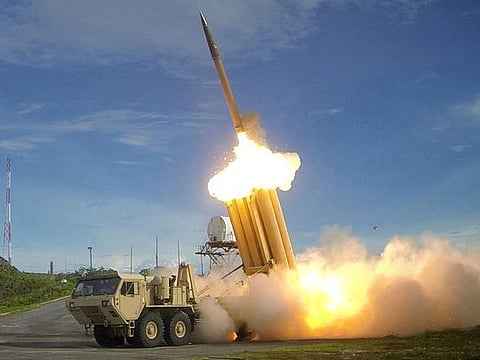US fired 20% of THAAD arsenal in 11 days, burning $810 million to shield Israel from Iran
Israel-Iran clash puts America’s high-tech missile defences to costly and critical test

Dubail: In a powerful yet costly show of force, the United States consumed an estimated 15 to 20 per cent of its global Terminal High Altitude Area Defence (THAAD) arsenal during a 11-day conflict aimed at shielding Israel from Iranian missile attacks.
According to Military Watch Magazine, 60 to 80 THAAD interceptors were launched between June 13-24, targeting a barrage of Iranian ballistic and hypersonic missiles.
With each interceptor costing $12 to $15 million, the US effectively burned through $810 million to $1.2 billion — a cost that dwarfs the Iranian outlay for its missile strikes.
The huge price tag reveals a serious flaw: America’s missile defense can’t keep up in a prolonged battle
Arsenal strained
Only 50 to 60 THAAD interceptors are produced annually, primarily by Lockheed Martin. At this rate, it could take the Pentagon years to replenish the inventory used up in a single short-lived conflict — especially alarming considering the global responsibilities THAAD bears in countering threats from various countries.
Video footage confirmed at least 39 launches, though experts believe the total figure is far higher due to Israeli wartime censorship. Military analysts estimate that two of the US’s seven global THAAD batteries were deployed to support Israel.
THAAD (Terminal High Altitude Area Defence) missile system
Purpose: Intercepts medium to intermediate-range ballistic missiles in their terminal phase (descent).
Cost per interceptor: $12–15 million
Annual US production: 50–60 interceptors
Deployed batteries globally: 7 (8th to be operational by end of 2025)
Used in 2025 Israel-Iran conflict: 60–80 interceptors (~15–20% of US stockpile)
Conflict duration: 11 days
Total estimated cost of THAAD use: $810 million – $1.215 billion
Countries Targeted by THAAD: Iran, North Korea, China, Russia, Belarus
Deployment Locations: Hawaii, Guam, South Korea, Israel, Wake Island (tested)
Limitations noted:
Poor efficiency against low-altitude and hypersonic missiles like Fattah-1
Vulnerable to mass salvos, decoys and cost-inefficiency in prolonged conflicts
Replenishment lag due to low production rate
Support systems in Israel: Arrow, Barak 8, Patriot, AEGIS (SM-3)
Strategic concern: Unsustainable in high-intensity or multi-front wars
While THAAD is designed to intercept medium and intermediate-range ballistic missiles, it struggled against Iran’s low-altitude projectiles and the hypersonic Fattah-1, which can travel at Mach 15 with unpredictable trajectories. Iran’s strategy of launching mass salvos, decoys, and non-critical targets forced THAAD to expend its costly interceptors inefficiently.
More fire, less effect
On June 18, a single barrage over Tel Aviv over-saturated THAAD and allied systems, engaging them with decoys and absorbing valuable resources. Experts warn this points to a deep structural imbalance in modern missile warfare — offence is cheap; defence is ruinously expensive, the magazine said.
Despite the use of multiple support systems including Israel’s Arrow, Barak 8, the US Patriot, and AEGIS destroyers armed with SM-3 interceptors, THAAD’s limitations stood out starkly.
Global implications
First deployed overseas in 2009 to protect Hawaii, and later in Guam (2013) and South Korea (2016), THAAD is now being considered for Europe, especially amid Russian deployment of Oreshnik missiles and Belarus’s acquisition of North Korean Pukkuksong-2 systems.
Sign up for the Daily Briefing
Get the latest news and updates straight to your inbox



